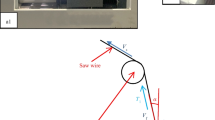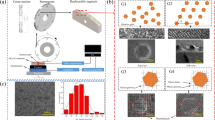Abstract
In order to improve the grinding wheel wear during the sapphire steep aspheric surface grinding process, a SiC-reinforced resin-bonded hemispherical diamond wheel was used and the arc envelope grinding performance was investigated. Firstly, the mapping relationship between the contours of the grinding wheel and the aspheric surface was established based on the grinding conditions. The wear of the hemispherical diamond wheel was modelled, and the result indicates that the maximum wear occurred at the edge of the hemisphere, decreases along the generatrix and increases near the center. Then, the form-trued diamond wheel was used for grinding the sapphire steep aspheric surface. The concave and convex surface form error obtained at the central part of Φ 50 mm are 2.5 μm and 1.3 μm, respectively. The surface roughness Ra is 230–450 nm, which is affected by the material removal rate and the sapphire crystal anisotropy. The SiC-reinforced resin-bonded diamond wheel possesses favorable self-sharpening ability and sufficient diamond grain retention capacity for sapphire grinding. The wear distribution shows that the most severe wear parts of the grinding wheel are at the edge and the center of the grinding zone, which is consistent with the model-predicted results.















Similar content being viewed by others
Abbreviations
- R :
-
Aspheric surface paraxial radius of curvature
- K :
-
Conic constant
- C i :
-
Coefficients of the aspheric surface
- β :
-
Inclination angle of tool spindle
- S v :
-
Surface area of wheel that participated in grinding
- r t :
-
Radius of hemispherical diamond wheel
- Δl w :
-
Arc length increment of grinding trajectory on the aspheric surface
- Δl t :
-
Arc length increment of grinding trajectory on the wheel surface
- \(\bar{K}\) :
-
Mean curvature corresponding to Δlw
- ρ w :
-
Radius of curvature along the aspheric surface generatrix
- θ′:
-
Turned angle of the grinding point on the wheel contour
- θ″:
-
Turned angle of the grinding point on the aspheric surface generatrix
- Δl t″:
-
Generatrix length of aspheric surface corresponding to Δθ″
- k wt :
-
Ratio of Δlw and Δlt″
- G :
-
Grinding ratio
- dV w :
-
Volume differential element of the material removal
- dV t :
-
Volume differential element of the grinding wheel wear
- dl w :
-
Differential arc-length on the aspheric surface corresponding to dVw
- dl t :
-
Differential length of grinding trajectory on the wheel surface corresponding to dVt
- dl t″:
-
Differential length along the aspheric surface generatrix corresponding to dlt
- a p :
-
Grinding depth
- a w :
-
Grinding wheel wear depth
References
Wegener, K., Bleicher, F., Krajnik, P., Hoffmeister, H. W., & Brecher, C. (2017). Recent developments in grinding machines. CIRP Annals, 66(2), 779–802.
Wang, Z., Yan, Y., Zhou, P., Si, L., Kang, R., & Guo, D. (2018). A high-efficient precision grinding for fabricating moderately thick plane mirror (MTPM). The International Journal of Advanced Manufacturing Technology, 96(5–8), 2559–2566.
Chen, B., Li, S., Deng, Z., Guo, B., & Zhao, Q. (2017). Grinding marks on ultra-precision grinding spherical and aspheric surfaces. International Journal of Precision Engineering and Manufacturing-Green Technology, 4(4), 419–429.
Wang, T., Cheng, J., Liu, H., Chen, M., Wu, C., & Su, D. (2019). Ultra-precision grinding machine design and application in grinding the thin-walled complex component with small ball-end diamond wheel. The International Journal of Advanced Manufacturing Technology, 101(5–8), 2097–2110.
Brinksmeier, E., Preuss, W., Riemer, O., & Rentsch, R. (2017). Cutting forces, tool wear and surface finish in high speed diamond machining. Precision Engineering, 49, 293–304.
Feng, M., Wu, Y., Wang, Y., Zeng, J., Bitoh, T., Nomura, M., et al. (2020). Investigation on the polishing of aspheric surfaces with a doughnut-shaped magnetic compound fluid (MCF) tool using an industrial robot. Precision Engineering, 61, 182–193.
Kuriyagawa, T., Zahmaty, M. S. S., & Syoji, K. (1996). A new grinding method for aspheric ceramic mirrors. Journal of Materials Processing Technology, 62(4), 387–392.
Chen, F., Yin, S., Huang, H., & Ohmori, H. (2015). Fabrication of small aspheric moulds using single point inclined axis grinding. Precision Engineering, 39, 107–115.
Hallock, B., & Shorey, A. (2009). Technologies for precision manufacture of current and future windows and domes. Window and Dome Technologies and Materials XI. International Society for Optics and Photonics, 7302, 73020V.
Fess, E., DeFisher, S., Cahill, M., & Wolfs, F. (2015). Development of manufacturing technologies for hard optical ceramic materials. Window and Dome Technologies and Materials XIV. International Society for Optics and Photonics, 9453, 94530C.
DeFisher, S., Fess, E., & Wolfs, F. (2013). Freeform and conformal optical manufacturing. Window and Dome Technologies and Materials XIII International Society for Optics and Photonics, 8708, 870813.
Chen, B., Guo, B., & Zhao, Q. (2015). An investigation into parallel and cross grinding of aspheric surface on monocrystal silicon. The International Journal of Advanced Manufacturing Technology, 80(5–8), 737–746.
Fess, E., & DeFisher, S. (2013). Advancements in asphere manufacturing. Optical Manufacturing and Testing X. International Society for Optics and Photonics, 8838, 88380M.
Wang, T., Wu, C., Liu, H., Chen, M., Cheng, J., Fang, Z., et al. (2019). Configuration design and accuracy analysis of special grinding machine for thin-walled small concave surfaces. Precision Engineering, 56, 293–302.
Liu, L., & Zhang, F. (2017). Prediction model of form error influenced by grinding wheel wear in grinding process of large-scale aspheric surface with SiC ceramics. The International Journal of Advanced Manufacturing Technology, 88(1–4), 899–906.
Li, Y., Funkenbusc, P. D., Gracewski, S. M., & Ruckman, J. (2004). Tool wear and profile development in contour grinding of optical components. International Journal of Machine Tools and Manufacture, 44(4), 427–438.
Li, W., Ren, Y., Li, C., Li, Z., & Li, M. (2019). Investigation of machining and wear performance of various diamond micro-grinding tools. The International Journal of Advanced Manufacturing Technology, 106(3–4), 921–935.
Azarhoushang, B., & Ludwig, S. (2019). In-process grinding wheel wear evaluation using digital image processing. International Journal of Abrasive Technology, 9(2), 99–112.
Xu, L. M., Fan, F., Zhang, Z., Chao, X. J., & Niu, M. (2019). Fast on-machine profile characterization for grinding wheels and error compensation of wheel dressing. Precision Engineering, 55, 417–425.
Guo, B., & Zhao, Q. (2017). Ultrasonic vibration assisted grinding of hard and brittle linear micro-structured surfaces[J]. Precision Engineering, 48, 98–106.
Yan, G., You, K., & Fang, F. (2019). Three-linear-axis grinding of small aperture aspheric surfaces[J]. International Journal of Precision Engineering and Manufacturing-Green Technology. https://doi.org/10.1007/s40684-019-00103-7.
Zhang, Z., Yang, X., Zheng, L., & Xue, D. (2017). High-performance grinding of a 2-m scale silicon carbide mirror blank for the space-based telescope. The International Journal of Advanced Manufacturing Technology, 89(1–4), 463–473.
Wang, J., Zhao, Q., Zhang, C., Guo, B., & Yuan, J. (2020). On-machine precision form truing and in situ measurement of resin-bonded spherical diamond wheel. Applied Sciences, 10(4), 1483.
Voloshin, A. V., Litvinov, L. A., & Slyunin, E. V. (2013). The influence of sapphire crystallographic orientation on surface roughness achievable by diamond abrasive machining. Journal of Superhard Materials, 35(1), 56–59.
Wang, J., Guo, B., Zhao, Q., Zeng, Z., Zhai, W., Chen, H., et al. (2019). Investigation into the anisotropy of cross-grinding surface quality in C-and M-planes of sapphire. Proceedings of the Institution of Mechanical Engineers, Part B: Journal of Engineering Manufacture, 233(1), 44–54.
Wang, J., Guo, B., Zhao, Q., Zhang, C., Zhang, Q., Chen, H., et al. (2017). Dependence of material removal on crystal orientation of sapphire under cross scratching. Journal of the European Ceramic Society, 37(6), 2465–2472.
Zhang, Q., To, S., Zhao, Q., & Guo, B. (2016). Surface damage mechanism of WC/Co and RB-SiC/Si composites under high spindle speed grinding (HSSG). Materials and Design, 92, 378–386.
Acknowledgements
This research work is supported by the National Natural Science Foundation of China [Grant nos. 51805484 and 51875135], and the China Postdoctoral Science Foundation [Grant no. 2019M652137].
Author information
Authors and Affiliations
Corresponding author
Ethics declarations
Conflict of interest
On behalf of all authors, the corresponding author states that there is no conflict of interest.
Additional information
Publisher's Note
Springer Nature remains neutral with regard to jurisdictional claims in published maps and institutional affiliations.
Rights and permissions
About this article
Cite this article
Wang, J., Zhao, Q., Zhang, C. et al. Arc Envelope Grinding of Sapphire Steep Aspheric Surface with SiC-Reinforced Resin-Bonded Diamond Wheel. Int. J. of Precis. Eng. and Manuf.-Green Tech. 8, 1083–1094 (2021). https://doi.org/10.1007/s40684-020-00225-3
Received:
Revised:
Accepted:
Published:
Issue Date:
DOI: https://doi.org/10.1007/s40684-020-00225-3




